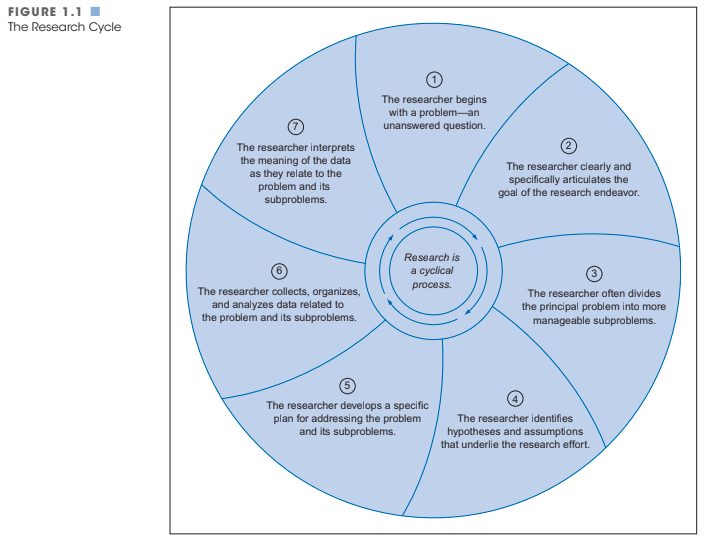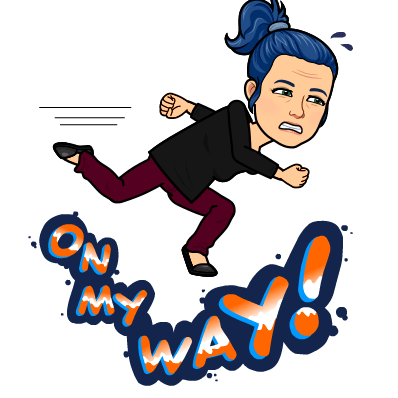Tag: Evidence Based Practice
What is research and how can we evaluate it?
INF447 Modules 1-5
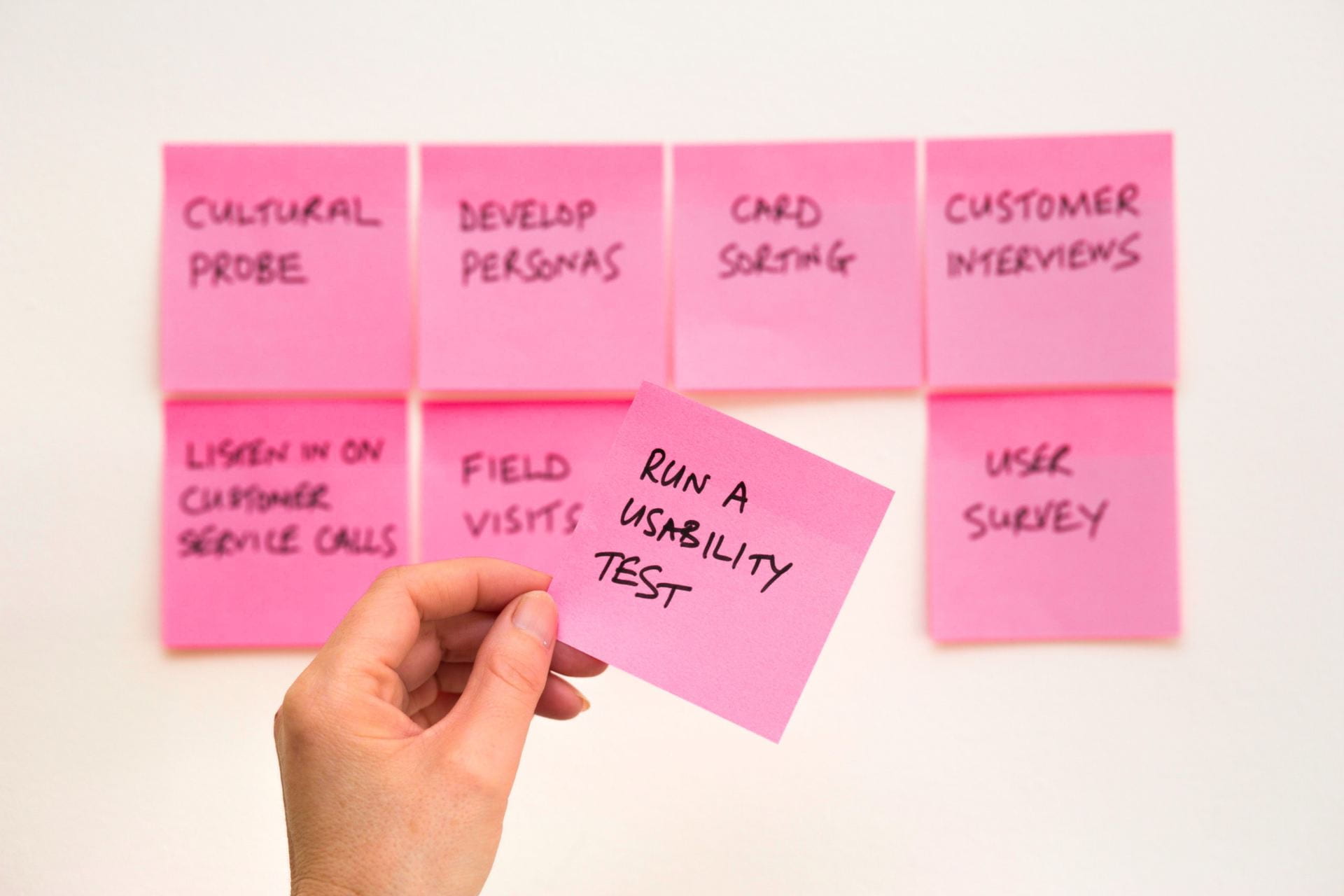
- Key words: Research is critical, creative, formal/systematic/scientific/pure/rigorous, applied, experimental/theoretical, investigating, understanding, interpreting, analysing, confirming/refuting, communicating and cyclical (Leedy & Ormrod, 2015):
- Researchers follow a process that could be referred to as G. R. Ac. E. Fi. (Gather information, Reflect on the meaning, Arrive at a conclusion, Evaluate the process and conclusion, and finally, put Forward an interpretation).
- We must understand the underlying philosophies of researchers such as positivism, post-positivism, constructivism, and pragmatism/realism (Leedy & Ormrod, 2015), as well as their methodologies, assumptions (according to Leedy & Ormrod, 2015, assumptions are facts or ideas accepted as true, usually determined or stated at the start of the research), and methods or design of research in order to validate or apply it into practice.
- Information gathering (or organising, summarising, discussing and referencing a ‘research report’) is not the same as ‘research’ because it misses the important step of interpreting or analysing the information or data (Leedy & Ormrod, 2015) and / or hypothesis (a hypothesis being: an open minded speculation, or “a logical supposition, a reasonable guess, an educated conjecture” according to Leedy & Ormrod, 2015 p22).
- There are 3 methods of research: 1. quantitative (quantity based), 2. qualitative (qualities based), and 3. mixed method research (utilising both quantitative and qualitative methods) hence the names (Leedy & Ormrod, 2015 p24).
- There are 3 paradigms of research: positivism (linked to quantitative / scientific method) using singular reality as a singular truth, interpretism, reality is built by individual(s) within particular context(s) interpreted subjectively by individuals (linked to qualitative), post-positivism says that the nature of being and existence is singular but that can be interpreted differently by each individual within their own context(s) (linked to mixed method research).
- Other topics in this module I will cover in my upcoming assessment task:
- Dissemination of research
- Audiences for research
- Evidence Based Library and Information Practice
- Evidence based practice
- Textbook
References
Leedy P. D. & Ormrod, J. E. (2015). Chapter 1 The nature and tools of research. In Practical research: Planning and design (11th ed., pp.19-26). Pearson/Merrill Prentice Hall. Retrieved from https://ebookcentral.proquest.com/lib/csuau/reader.action?docID=5176197&ppg=20
How should educators design / develop / create / manage a digital learning environment (DLE)? (ETL523 Modules 3-5)

Why create a quality DLE?
The reasons behind and processes for creating a quality DLE is much like creating a ‘Learning Commons,’ (which I’ve discussed in two previous posts from ETL503 Resourcing the Curriculum: click here and here).
How do we create a quality DLE?
The article from Chen & Orth (2013) is absolutely amazing, not only because it points out that we must link the school DLE to the home DLE, but also because they outline the key steps to creating a quality DLE starting with 1. forming a group  of stakeholders, creating a shared vision and core beliefs, then 2. training, communicating with or informing all stakeholders, followed by 3. implementing the DLE plan of lessons and concepts of digital citizenship and digital literacy, completing the circle by 4. evaluating and reviewing the DLE regularly.
of stakeholders, creating a shared vision and core beliefs, then 2. training, communicating with or informing all stakeholders, followed by 3. implementing the DLE plan of lessons and concepts of digital citizenship and digital literacy, completing the circle by 4. evaluating and reviewing the DLE regularly.
How do we manage the DLE to foster globally connected learning?
As recommended by Lindsay (2016), we need to:
- Discuss the digital footprints or ‘branding’ of all students and make sure they are using long-term appropriate and culturally sensitive language and images.
- Consider the digital divide and make sure that platforms, discussion tools and global or local connections are provided synchronously (in real time) and asynchronously (offline or pre-recorded).
- Create a DLE that offers students opportunities to authentically and collaboratively engage with peers globally. (Lindsay, 2016).
How can we manage the DLE to move students from social media citizens to social media leaders?
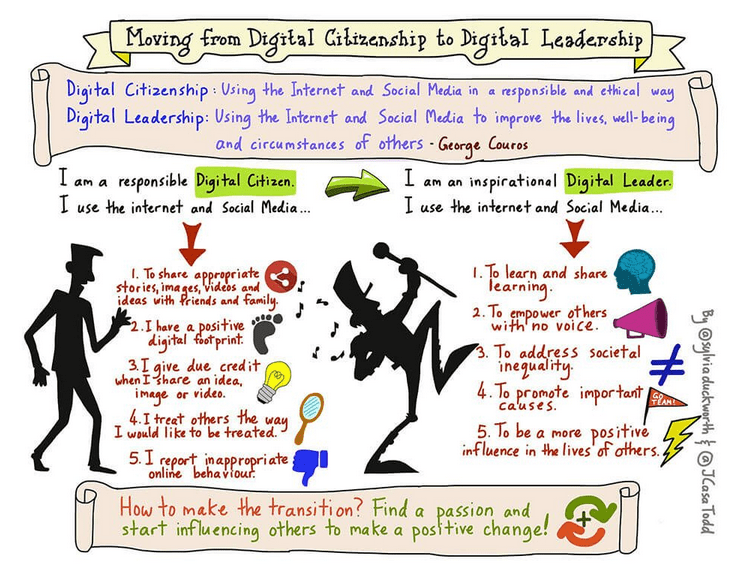
References
Casa-Todd, J. (2016). Rethinking Student (Digital) Leadership and Digital Citizenship [Image]. Retrieved from: https://jcasatodd.com/rethinking-student-digital-leadership-and-digital-citizenship/
Lindsay. J. (2016, July 19). How to encourage and model global citizenship in the classroom. Education Week. Retrieved from http://blogs.edweek.org/edweek/global_learning/2016/07/how_to_encourage_and_model_global_citizenship_in_the_classroom.html
Chen, E., Orth, D. (2013). The strategy for digital citizenship. NAIS Independent School Magazine (online) http://www.nais.org/Magazines-Newsletters/ISMagazine/Pages/The-Strategy-for-Digital-Citizenship.aspx.
Protected: My Flowcharts of Organisational Structures and Leadership Theories
Reflecting on Organisational, Managerial and Leadership Theory 2.2-2.3
REFLECTIVE: “Derive happiness in oneself from a good day’s work, from illuminating the fog that surrounds us.” Henri Matisse
(Matisse n.d.)

It is amazing to me how we all grow up getting used to the amazing structures of the past without acknowledging their significance in our present. Much like the ancient buildings showing through the fog in the image from Simon Matzinger (above) so are the structures of organisational, managerial and leadership theory from past and present all around us.
If we don’t take the time to reflect on and recognise the structures that exist and influence our actions, we are but living in a fog. Thus, I’ve spent a lot of time and brain energy this week on the subject…and as I peer into the fog of the history and research, I fear I have but scratched the surface.
I’m not alone in my experiences of poor leadership/management/organisational structure. I’m sure many of us in our mid 30’s and beyond have some war stories to tell…in my very first officially paid position in a grocery store, the front end manager and his assistant stole nearly $40 000 from the company (which became evident in the scandal that erupted when I accidentally took home a pack of $1 bills in my apron and nobody noticed until I turned it in the next day). Was this because they lacked the necessary leadership ‘trait‘ of integrity but it was assumed that they had that trait when they were hired? Was this because of the organisational structure being ‘divisional’ (Kokemuller, 2017) without actually any vision or sharing of vision?
I had quite a few retail positions in my youth. In one position, I worked in a bookstore and the manager was passive aggressive and controlling, possibly anal retentive…he would put dusting skills into our performance appraisals as a critique and used a texta to draw outlines of where he wanted the office supplies to go. Everyone on staff was very friendly and hard working and we all just managed ourselves and the store with very little need for input from him. Was this because of his leadership skill or ‘traits’ and lack thereof? Was he in an environment that called for a ‘transformational’ leader but he was stuck in the ‘autocratic’ leadership mindset? Did he have a lack of control over us that made him feel irrelevant?
POWER: “Part of the task of the leader is to make others participate in his leadership. The best leader knows how to make his followers actually feel power themselves, not merely acknowledge his power” … “Leadership is not defined by the exercise of power but by the capacity to increase the sense of power among those led. The most essential work of the leader is to create more leaders” Mary Parker Follet (in Janse 2019).
In my office worker years, I learnt that I am good at being an office worker, in that I can do the work to a very high standard. I can type and shuffle papers and find quick and cost effective solutions to most any problem. I watched as many of my white, male colleagues received promotions despite the fact that I was doing the same job much better than they had been. And, oh boy, do I hate the lack of humour, the dearth of beauty, the monotony and, most of all, the sense that I was not doing anything that improved the world. Why are offices so often designed in the ‘divisional’ (Kokemuller, 2017) way? Why do people who socialise really well receive promotions when people who do their jobs really well remain in those positions – is it because some people are perceived to have more ‘statesmen’ ‘traits’ and that makes them more suited to leadership positions? How actually important is it to be able to do the job of the subordinate well prior to or while being a leader of that subordinate? Is it part of being more efficient within the ‘scientific‘ management theory?
When I became a teacher (in the Australian education system), my first impression still rings true: schools try to mimic what they believe business structures to be like. A parody of sorts. A reproduction. However, there is one key difference in the business structure of education: our shared goal to improve outcomes for the children at our schools, and indeed, thus improve the world. We shouldn’t limit ourselves to the machine or divisional organisation structures. We have it in our capacities to aim for the ‘professional’ and ‘innovative’ structures (Kokemuller, 2017). Let’s lead the way for business, not the other way around!
VISION: “The most successful leader of all is the one who sees another picture not yet actualised. (They see) the things which are not yet there… Above all, (they) should make (their) co-workers see that it is not (the leader’s) purpose which is to be achieved, but a common purpose, born of the desires and the activities of the group” Mary Parker Follet (in Janse 2019).
I’ve been told, at various times in my teaching career, that I got my degree the ‘easy’ way or ‘through the back door’ by doing an early childhood degree. I sometimes hear little snippets about where I should be placed within a school because of this also…as if I am not capable of working with older students because my university training 12 years ago, despite the fact that as a casual teacher I’ve worked with ages 3 to 14. Even in the first case study for ETL504, I was curious why one of the ’employees’ needed her degree specialisation to be pointed out. Was it because we have to treat early childhood trained educators differently because they aren’t as clever as the rest? Is this part of the bureaucratic and ‘divisional,’ ‘machine’ organisational structures, or are we identifying the early childhood specialisation as a means to create a ‘professional’ structure (Kokemuller, 2017)?
APPRECIATION: “Unity, not uniformity, must be our aim. We attain unity only through variety. Differences must be integrated, not annihilated, not absorbed” Mary Parker Follet (in Janse 2019).
As written in my previous post on this blog (see below) entitled “Creating a Collaborative Climate – The Triple C’s” on the 21st of May 2019, we are expected to collaborate when so much of the stuff behind the scenes or ‘beneath the fog’ isn’t set up effectively. The amount of control we have over the organisational set up is limited, those old buildings have been around for too long and are stronger than one person. However, we can work on building a collaborative climate within those organisational structures. In addition to the items listed in my Triple C blog post, I would add team building to the list.
INVENTION “Conflict is resolved not through compromise, but through invention” Mary Follet Parker (in Janse 2019).
Team building is something in which office human resources managers are proficient and schools would do well to take note of their advice. Trust, communication, conflict resolution and productivity are increased when team building occurs (Al-Bakri 2017). In my Triple C blog post, I recommended and I still recommend that instead of ‘meetings’ where information is disseminated, we could host ‘yarning circles’ as recommended by The Salvation Army (Worthing, 2018). While I am not promoting and am not religious, I respect the ideas recommended and would love to host a staff yarning circle in my library with my team. I’d also like to investigate team building activities such as those provided by beyond the boardroom or other companies in Australia.
Until then, here is my previous blog post on workplace climate change:
References
Al-Bakri, S. (2017). Why every organisation should embrace team activities. Retrieved from https://www.hrmonline.com.au/social-media/organisation-embrace-team-activities/
Janse, B. (2019). Mary Parker Follett. Retrieved from toolshero: https://www.toolshero.com/toolsheroes/mary-parker-folett/
Kokemuller, N. (2017). Mintzberg’s five types of organizational structure. In Hearst Newspapers: Small business. Retrieved from http://smallbusiness.chron.com/mintzbergs-five-types-organizational-structure-60119.html
Matisse, H. (n.d.) Henri Matisse Quotes, BrainyQuote.com. Retrieved from https://www.brainyquote.com/quotes/henri_matisse_140869
Worthing, S. (2018). The Yarning Circle. Retrieved from https://others.org.au/features/the-yarning-circle/
Protected: And so our story ends as it began…with a blog post
The New Paradigm Part 1 of 2
(Reflection ETL401 Module 4 – The Teacher Librarian and the Curriculum)
(RSA Animate 2008) This is a very powerful video that offers a dichotomous view of an ‘education paradigm’.
Throwing the baby out with the bath water: While I agree that there has been (or in some cases, needs to be) a shift in the Australian education system, I am hesitant to throw out the baby with the bath water and dispose of outcomes. I have had great success with my students by utilising the NSW syllabus document outcomes and indicators. These have been regularly updated and rearranged over the years and each update, in my opinion, has improved the approach.
Similarly, so have approaches such as ‘play based learning’ or the ‘Reggio Emilia Approach’ / the environment as the ‘third teacher’ (Wein 2015), integrated units such as COGS and inquiry based learning (IBL) such as The Big6 or the Super3 / project based learning (PBL) models evolved over time and have been accepted and used by teachers to varying degrees and with varying degrees of success.
A Breath of Fresh Air: Anyone in the education system for more than 5 years will have seen enough new ideas blow in to the educational sphere to know that they generally blow straight back out to make room for the next big breeze, and leave very little in their wake in terms of real change.
I don’t think this ‘New Paradigm’ is a situation of ‘outcomes based learning’ vs ‘inquiry based  learning.’ I don’t think the two need to be pitted against each other in an argument reminiscent of the recent arguments about how to teach literacy as seen in media and other outlets, for example as per this 2017 blog post by Eleanor Heaton about phonics versus the whole language approach.
learning.’ I don’t think the two need to be pitted against each other in an argument reminiscent of the recent arguments about how to teach literacy as seen in media and other outlets, for example as per this 2017 blog post by Eleanor Heaton about phonics versus the whole language approach.
I see no reason why we can’t have both and simply be more flexible in the application of outcomes to meet real individual student needs.
The real issues with outcome based teaching are based in 1. a lack of authentic growth mindset (Dweck 2006) in adults and students – an inability to see mistakes as part of learning, 2. the social debate regarding reporting to parents and telling the students themselves or their parents that their child has or has not met stage outcomes based on a ‘letter’ mark or tick in a box. Far better, according to Hattie & Peddie (2003), for the system to simply say, ‘this is what sorts of things you/your child can do well, these are things that they are still learning or here are the learning goals for the future.’ It isn’t the outcomes at fault, it is how we’ve applied them to our practice as educators.
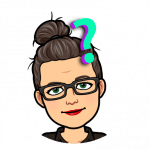 [Sidebar 1: To this end, I am extremely interested in the Quality Teaching Framework to improve the structure of lesson delivery (if this is done through inquiry based teaching then so be it) and reading more about ability/interest/friendship grouping of students as opposed to age/year/stage grouping of students.]
[Sidebar 1: To this end, I am extremely interested in the Quality Teaching Framework to improve the structure of lesson delivery (if this is done through inquiry based teaching then so be it) and reading more about ability/interest/friendship grouping of students as opposed to age/year/stage grouping of students.]
[Sidebar 2: If you think Outcome based teaching is holding students back, don’t even get me started on the ‘Learning Progressions,’ ‘NAPLAN’ and the ‘Our Schools’ Website / league tables which have resulted in ‘teaching to the test’ and ‘school shopping.’ Gah.]
[Sidebar 3: If outcome models are so flawed and inquiry models are so perfect, why aren’t universities scrapping outcome based marking criteria and using inquiry models?]
Making assumptions about students: How students find information and their level of ability, particularly when it comes to electronic resources varies widely – much more so than adults realise and according to Coombes, “The basic premise of the Net Generation theory, that familiarity with technology equates with efficient and effective use and these achievements are only applicable to a specific group because they have grown up with technology, is flawed” (Coombes 2009, pp.32).
Technology is a tool, rather than a solution (Coombes 2009). Society has a new ‘digital age’ environment in which we live and we are expecting students to learn how to navigate it simply by being born amongst it. We have a new set of digital expectations in our society but have neglected to update our education system of our students to enable them to meet those expectations.
Information Search Process (ISP) skills / information literacy: Being able to recognise functions of a digital device does not automatically mean that students are able to access, process and absorb information on that they come across on said device (Coombes 2009). Students are overly reliant on the internet, have limited ability to search effectively, and are rarely able to critically evaluate information that they find (Coombes 2009).
The Role of Teacher Librarians (et al.): Educators have responsibility to lift their game when it comes to teaching students information literacy / searching skills such as collecting, managing and evaluating information (particularly when they believe the first thing that appears in their search is the most relevant or most accurate when in fact the first thing that comes up is based on their prior searches and the search engine’s popularity algorithms), finding the information again at a later date, and storing information for future use (Combes, 2007b in Coombes 2009).
Evidence and Assessment within the library: I like the list of ideas in ETL401 Module 3 (based on Valenza 2015) for evidence that the library program is of benefit to the school teaching and learning programs and curriculum. However, I am wary of introducing something that is trivial or that will not stand the test of time or that might sit in a filing cabinet – lost and forgotten.
For that reason, I will use the Quality Teaching Framework and the subsequent evaluation sheet (that I modified on GoogleDocs) to evaluate my lessons or units of work professionally, and will also use the (yet to be created) school library website or more private/access restricted photo/video-based programs (where accepted by the school) for evidence of student engagement or achievement such as ClassDojo, Seesaw or ClassCraft. The benefit of these applications is that they are also able to be used by students themselves, with any device (at home or at school).
I’m looking at you, teachers who profess to be techno-phobes! As Coombes’ 2009 work was written 10 years ago, and research within her article is based on the 10 to ‘teen’ age range, most of the students in her focus are now adults and quite possibly, teachers themselves. Those who are from current and previous generations, as educators, need to be aware of our own gaps in information literacy so that we can stop the cycle of poor information seeking skills!
The Blame Game: What I’ve also seen in education, in varying degrees based on context, is a lack of personal and professional reflection. A lack of ‘mindfulness’ and being in the moment. A wish for the utopian environment and an unrealistic desire for perfect students who fit into a mould and live up to unrealistic expectations and students who are compliant rather than collaborative (Goss & Sonnemann 2017).
This results in a filtering down of ‘blame’ for the poor foundational (primarily literacy and numeracy) skills that students have when they arrive into high school. The high school teachers blame the stage 3 teachers. The stage 3 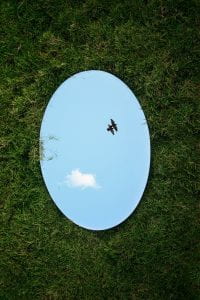 teachers blame the stage 2 teachers. The stage 2 teachers blame the stage 1 teachers. The stage 1 teachers blame the kindergarten/prep teachers. The kindy/prep teachers blame the preschools. (And everybody blames the RFF teachers and the parents and finally, the students themselves).
teachers blame the stage 2 teachers. The stage 2 teachers blame the stage 1 teachers. The stage 1 teachers blame the kindergarten/prep teachers. The kindy/prep teachers blame the preschools. (And everybody blames the RFF teachers and the parents and finally, the students themselves).
What I’d like to see is every person involved in education taking a look in the mirror and reflecting daily on their pedagogical practice. What I’d like to see is everyone practising mindfulness–thoughtfully doing what they can with the students and contexts that they have in the moment in time in which they are living, and authentic growth mindset–appreciating that mistakes are part of learning.
References:
Combes, B. (2009). Generation Y: Are they really digital natives or more like digital refugees? Synergy, 7(1), 31-40
Dweck, C. (2016). What having a “growth mindset” actually means. Harvard Business Review, 13, 213-226.
Goss, P. & Sonnemann, J. (2017). Engaging Students – Creating classrooms that improve learning. Retrieved from: https://grattan.edu.au/wp-content/uploads/2017/02/Engaging-students-creating-classrooms-that-improve-learning.pdf
Hattie, J., & Peddie, R. (2003). School reports: “Praising with faint damns.” Journal issue, 3.
RSA Animate – Robinson, K. (2008). Changing educational paradigms. Retrieved from https://www.youtube.com/watch?v=zDZFcDGpL4U#aid=P8wNMEma2ng
Valenza, J. (2015). Evolving with evidence: Leveraging new tools for EBP. Knowledge Quest. 43/3, 36-43
Wien, C. A. (2015). Emergent curriculum in the primary classroom: Interpreting the Reggio Emilia approach in schools. Teachers College Press.

